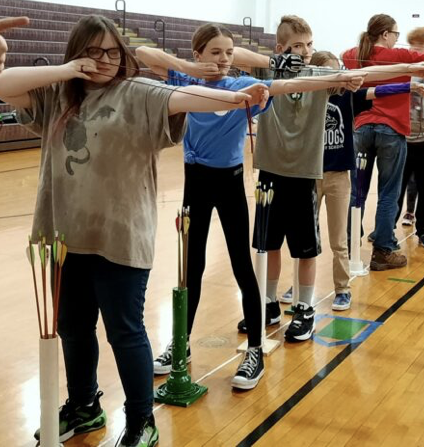A four-page piece of legislation that protects federal funds for school archery and hunting programs from being cut by federal bureaucrats illustrates the many perverse effects of giving Uncle Sam control over America’s education system.
The nearly 60-year-old Elementary and Secondary Education Act of 1965 (ESEA) is the multi-headed hydra that provides virtually unlimited ways by which U.S. Department of Education bureaucrats can directly and indirectly control all manner of programs in schools across the country.
The reach of these tentacles is lengthened whenever an unrelated piece of legislation applies – or can be interpreted to apply – to schools. This is exactly what Miguel Cardona, President Biden’s Education Secretary, did after his boss in 2022 signed the Bipartisan Safer Communities Act (BSCA), a knee-jerk legislative response to the tragic mass shooting at a school in Uvalde, Texas, that same year.
The BSCA contained a number of gun control measures, such as funding incentives for so-called “Red Flag Laws,” but did not prohibit use of federal education funds for such school programs as archery and hunter safety courses. It did, however, include language intended to prevent federal funds from being used to provide any “dangerous weapon” (that is, a firearm) or “training in the use of a dangerous weapon” in schools. This provision was intended to stop moves by some schools to arm teachers, resource officers, and administrators as a way to protect against criminal shooters at schools.
Cardona’s Department, however, saw an opportunity to expand the restrictive language in the BSCA, and ran with it.
Last July, the Education Department issued one of its dreaded “guidance letters” declaring that hunting and archery programs in schools would no longer be eligible to receive any federal funding, because such activities necessarily involved “technically dangerous weapons.”
The problem here is that the way a “dangerous weapon” is defined under federal law is so broad that virtually any Swiss Army knife no matter how small, or any metal-jacketed pen, could be read to fall within its ambit – which is precisely what Education Department bureaucrat Sarah Martinez proceeded to do in her “guidance” letter concerning archery and hunting education programs.
This action by the Education Department was taken not because the legislation as signed by Biden placed any restrictions on such school programs (it did not), but only because the Department simply decided to interpret it that way.
The guidance letter had precisely the “chilling effect” on such programs desired by the Department. Many school administrators, concerned that they could potentially be violating federal law if they allowed such benign programs to continue in their schools, ordered them stopped.
Tommy Floyd, president of the National Archery in the Schools Program, which oversees archery programs in some 9,000 schools with 1.3 million student participants, summed it up this way: “any time the U.S. Department of Education gives guidance about anything . . . [and] until I know the final answer, I’m probably going to pause.”
Congress responded quickly for once
That would have been the death knell for archery and hunting programs in schools, but for unusually quick action by congressional supporters of such programs.
The “Protecting Hunting Heritage Act” was introduced in the House on August 1 as H.R. 5110, and its four-page text clarified what never had been the intent of the BSCA – namely, that the prohibitory language in that 2022 legislation did not apply to “training in archery, hunting, or other shooting sports” programs in schools covered by the omnibus ESEA. With a vote of 424-1, the Protecting Hunting Heritage and Education Act was approved, receiving support from 216 Republicans and 208 Democrats.
By late last month, the clarifying legislation had overwhelmingly passed both houses of Congress and awaits President Biden’s promised signature.
It is laudable that Congress, in this age of nearly impenetrable partisanship, was motivated to attack this abuse of federal education control, and to do so swiftly. However, the problem and process that led to the need for such action illustrates all that is wrong with America’s public education system, with its top-down control by a massive and intimidating Education Department.
In this perverse system, bureaucrats with an ideological agenda such as opposition to any activity remotely deemed by them to support firearms or any type of “weapons,” can move to block students from benefitting from such programs as archery, and hope that those in the Congress harboring opposing views do not notice.
Thank goodness that in this instance Congress did notice, but consider all the other instances of such “guidance” abuse that slip by unnoticed.
Bob Barr represented Georgia’s Seventh District in the U.S. House of Representatives from 1995 to 2003. He served as the United States Attorney in Atlanta from 1986 to 1990 and was an official with the CIA in the 1970s. He now practices law in Atlanta, Georgia and serves as head of Liberty Guard.
The Value of Archery in Schools: Every year, more than 1.3 million students in almost 9,000 schools in 49 states participate in the NASP archery programs. More than merely learning archery, Dr. Floyd notes, these students develop life skills: learning the ability to handle pressure and deal with success and failure, and building self-confidence through acquiring the skills of archery.
What’s more, the student archers gain insight into the benefits of sportsmanship, experience positive role models, learn to focus within the classroom and ultimately feel more engaged with their schools. In fact, 58 percent of surveyed NASP® students indicated that the program helped them feel more connected with their school, and 40% reported that the archery program was a motivational factor for them to do better in the classroom!
Archery is that rare sport that appeals equally to both genders as male and female students compete side-by-side. In fact, archery is often pursued by students who have experienced physical, developmental or other challenges.
